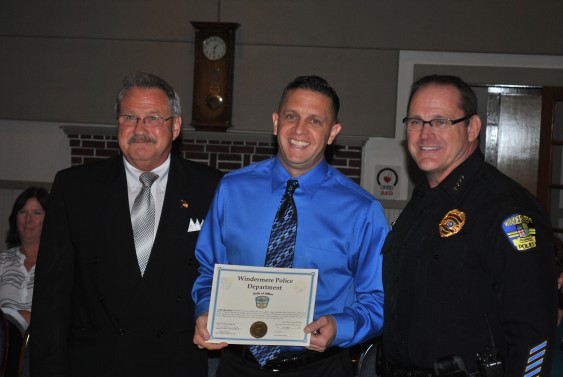- July 26, 2024
-
-
Loading

Loading


Although the development team for Windsong at Windermere presented some revised plans from the Oct. 14 meeting at the council’s request, the team requested at the Nov. 11 meeting to table decisions on the plans until the meeting Dec. 9.
With a vote of 4-1, the Windermere Town Council did table the development considerations.
Councilwoman Molly Rose opposed the tabling, saying she was still dissatisfied with the same size issues as she was in October.
“I strongly believe there should be a half-acre minimum (per lot), so that it fits in with the character of Windermere,” Rose said. “I feel that all of our setbacks should be adhered to…I checked, and there’s 15 lots that are greater than or equal to .4 acres, and there’s 35 that are less than that, closer to a third of an acre. Also, I don’t want to see clear cutting. We should follow our tree ordinance.”
Although councilman John Armstrong voted in favor of tabling the motion to give the developers more time, he also had carryover reservations about the plan’s lot sizes and setbacks, which he maintained he would not compromise on further. He also said there were still problems with the density, in terms of the ratio of lots to acres.
David Evans, president of Evans Engineering, said the Windsong team had revised plans to ensure average lot size was .4 acres and that no lot was smaller than .33 acres.
“You’ll see that there was substantial change, and it cost five lots in the process,” he said.
The council voted 3-2 in favor of a multi-modal and safety analysis from Kimley Horn and Associates, at a cost of $24,780.
“It’s a lot of money to find out where we’ll put crosswalks,” Rose said. “I think that we’ll put sidewalks anywhere we can do it when we can afford it. I’m not sure we need to spend $24,780 to find out where to put crosswalks.”
Councilman Jim O’Brien said that the idea behind the study was to see which sidewalks needed updating, so that there could be uniformity throughout Windermere on sidewalks.
“I think, from a long-range planning perspective, part of the reason that we want to do this is because we have a serious barrier,” O’Brien said. “We’ve got missing sidewalks, cracked sidewalks; I believe a lot of the emphasis was where we could get the most bang for the buck and have some continuity within our sidewalks.”
Armstrong agreed with Rose’s initial thoughts, voting with councilman Mike Pirozzolo against the contract.
“Why do we need the study to find out where to put some crosswalks near the center of the town, so that residents of the town will feel safer to cross the road?” Armstrong asked. “We don’t even have stop signs (near that area). I don’t know why we can’t figure that out without a big study.”
Town Manager Robert Smith said the staff that had reviewed the contract recommended it because it could help unify the sidewalks of the town, both in quality and connection.
“There was a discussion of connecting the downtown core to the commercial road, and then also the possibility of connecting it to the (elementary) school,” Smith said. “We have such a piecemeal approach when it comes to the actual sidewalks. They were constructed not only in inappropriate places but with inappropriate materials. You got sidewalks that are pretty chewed up because they were built on sand. What we wanted to get out of this was to figure out where we have the sidewalks and where we need to connect the roads and sidewalks to recreational, school and commercial (areas). This study could give us a series of phases in which to build the sidewalks. If not, we’d be using our best judgment in piecemeal again. We wanted to look at things holistically. Having an engineering study behind this helps (the council).”
Rose had a concern of whether sidewalks would be designated to include considerations for golf carts.
“We approved golf carts on our secondary roads not long ago,” Rose said. “We have an issue that our carts can’t get over the bridge to downtown. We wanted to include in the study what would be done to improve that access. There was a study to allow carts to get to supermarkets on Apopka-Vineland Road, for instance. I think people will start to use other modes, such as golf carts, to use less gas and be more environmentally friendly.”
The study included specific sections pertinent to pedestrians and bicycles but not specific to golf carts. Golf carts were included in a miscellaneous section for various other modes.
Despite her initial reservations, Rose’s vote to pass the measure made the difference in its passing.
“(Pirozzolo) said we do these studies and then don’t follow through because they don’t help our situation in town,” Rose said. “For this study, I’ve been trying to get a crosswalk between 6th and Chase. They for some reason put one at 9th and 10th avenues, but no one uses it. Every time we try to get a new one, they tell me we have to have a study first. The immediate concern is the amount of people and traffic during rush hours. For people like me out walking our dogs, nobody stops unless there is a crosswalk. I think in the long-term it gives us the information needed. In the short-term, it gives us this crosswalk and maybe others we need.”
The council discussed an annexation of Bird Island, out of councilman Richard Gonzalez’s environmental concerns; renaming Butler Bay Park for slain policeman Robert German; and a study recommending the removal of stop signs on Maguire Road at its intersection with Windermere Road. The discussions resulted in no seconded motions.
Contact Zak Kerr at [email protected]